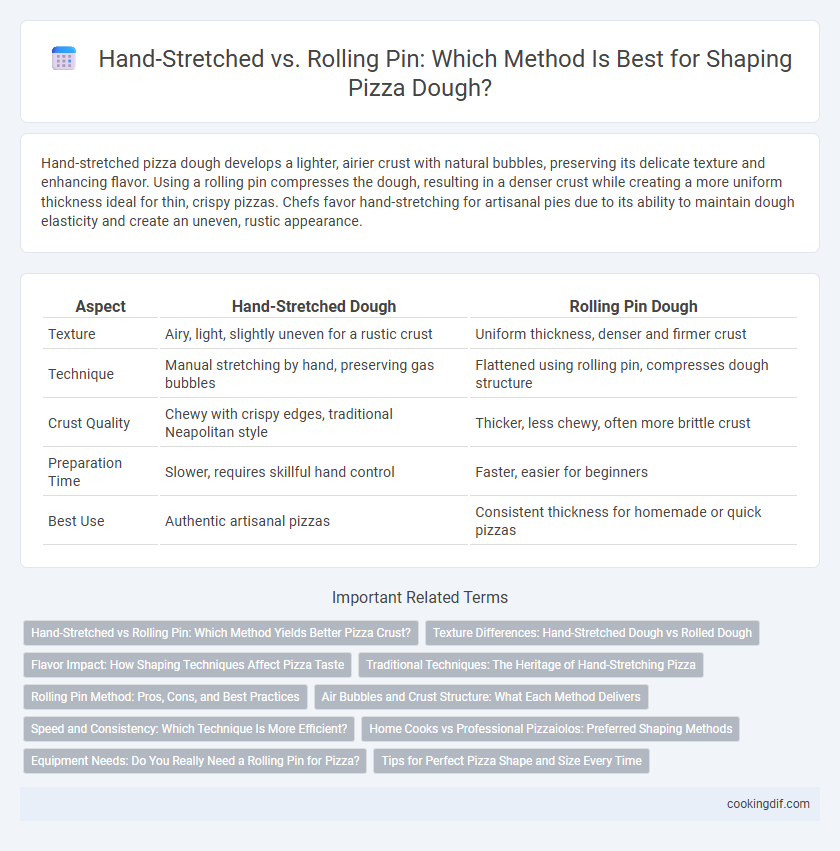Hand-stretched pizza dough develops a lighter, airier crust with natural bubbles, preserving its delicate texture and enhancing flavor. Using a rolling pin compresses the dough, resulting in a denser crust while creating a more uniform thickness ideal for thin, crispy pizzas. Chefs favor hand-stretching for artisanal pies due to its ability to maintain dough elasticity and create an uneven, rustic appearance.
Table of Comparison
| Aspect | Hand-Stretched Dough | Rolling Pin Dough |
|---|---|---|
| Texture | Airy, light, slightly uneven for a rustic crust | Uniform thickness, denser and firmer crust |
| Technique | Manual stretching by hand, preserving gas bubbles | Flattened using rolling pin, compresses dough structure |
| Crust Quality | Chewy with crispy edges, traditional Neapolitan style | Thicker, less chewy, often more brittle crust |
| Preparation Time | Slower, requires skillful hand control | Faster, easier for beginners |
| Best Use | Authentic artisanal pizzas | Consistent thickness for homemade or quick pizzas |
Hand-Stretched vs Rolling Pin: Which Method Yields Better Pizza Crust?
Hand-stretched pizza dough preserves air bubbles, resulting in a lighter, chewier crust with a more authentic Neapolitan texture. Using a rolling pin compresses the dough, often leading to a denser, less airy crust that lacks the characteristic flare and crispness of hand-stretched pies. Professional pizzaiolos prefer hand-stretching for its ability to create superior dough elasticity and a perfectly blistered crust in high-temperature ovens.
Texture Differences: Hand-Stretched Dough vs Rolled Dough
Hand-stretched pizza dough produces a lighter, airier crust with a chewier texture due to the gentle stretching preserving gas bubbles within the dough. Rolled dough tends to have a denser, more uniform texture as the rolling pin compresses the dough, eliminating some of the natural air pockets. This difference in handling significantly impacts the final bite, with hand-stretched pizzas offering a more traditional, open crumb structure.
Flavor Impact: How Shaping Techniques Affect Pizza Taste
Hand-stretched dough preserves air bubbles, producing a lighter crust with complex, slightly tangy flavors from fermentation, while rolling pins compress dough, resulting in a denser texture that can limit flavor development. The gentle stretching technique helps maintain gluten structure, enhancing chewiness and allowing better heat absorption for more balanced cooking. Rolling can create uneven thickness, impacting sauce and topping integration, which ultimately affects the overall taste experience.
Traditional Techniques: The Heritage of Hand-Stretching Pizza
Hand-stretched pizza dough preserves the traditional heritage by allowing precise control over thickness and texture, creating a light, airy crust with a characteristic chewiness. This technique naturally maintains the dough's gluten structure without overworking, unlike a rolling pin which can compress and toughen the dough. Authentic pizzerias favor hand-stretching to achieve a rustic, artisanal quality that defines classic Neapolitan and other heritage-style pizzas.
Rolling Pin Method: Pros, Cons, and Best Practices
Using a rolling pin for shaping pizza dough offers uniform thickness and speed, making it ideal for consistent thin-crust pizzas. However, this method can overly compress the dough, reducing air bubbles and resulting in a denser crust lacking the light, airy texture achieved through hand-stretching. Best practices include gentle rolling with minimal pressure and resting the dough between rolls to maintain elasticity and avoid toughness.
Air Bubbles and Crust Structure: What Each Method Delivers
Hand-stretched pizza dough preserves air bubbles, creating a light, airy crust with a characteristic chewy texture and irregular crumb structure ideal for Neapolitan-style pizzas. Using a rolling pin compresses the dough, resulting in fewer air pockets and a denser, more uniform crust that suits thin-crust and cracker-style pizzas. Choosing between these methods impacts the final texture, with hand-stretching enhancing crust elasticity and rolling pin shaping producing a crispier, more compact base.
Speed and Consistency: Which Technique Is More Efficient?
Hand-stretched pizza dough offers faster shaping with immediate responsiveness to pressure, enabling a more organic and airy crust, whereas rolling pins ensure uniform thickness and shape, promoting consistent cooking outcomes. For pizzerias aiming for high-volume production, rolling pins provide repeatable speed and size control, reducing variability in each pizza base. However, hand-stretching enhances dough aeration and texture but requires skilled hands, making it less efficient for speed and consistency in large-scale operations.
Home Cooks vs Professional Pizzaiolos: Preferred Shaping Methods
Home cooks often favor rolling pins for shaping pizza dough due to ease and consistency, while professional pizzaiolos prefer hand-stretching to preserve air bubbles and achieve optimal crust texture. Hand-stretching allows chefs to maintain dough elasticity and develop a characteristic airy, chewy crust, key to Neapolitan-style pizzas. Rolling pins can compress the dough, making it denser, which suits thicker or pan-style pizzas typical in home kitchens.
Equipment Needs: Do You Really Need a Rolling Pin for Pizza?
Hand-stretched pizza dough relies on skill and control, requiring minimal equipment beyond a clean surface, while a rolling pin demands less technique but may compress the dough, affecting texture. Pizza chefs often prefer hand-stretching to preserve air bubbles for a lighter crust, eliminating the need for a rolling pin altogether. Investing in high-quality stretchable dough and a sturdy wooden peel proves more essential than purchasing a rolling pin specifically for pizza preparation.
Tips for Perfect Pizza Shape and Size Every Time
Hand-stretched pizza dough retains air bubbles, creating a lighter, chewier crust, while rolling pins flatten dough uniformly but may compress texture. To achieve perfect pizza shape and size every time, gently stretch the dough from the center outward with your fingertips, avoiding excessive force. Allow the dough to rest between stretches to relax gluten, ensuring an even, round pizza base without tears or thin spots.
Hand-stretched vs rolling pin for shaping Infographic

 cookingdif.com
cookingdif.com